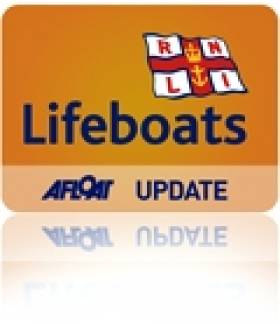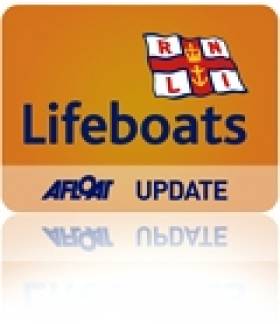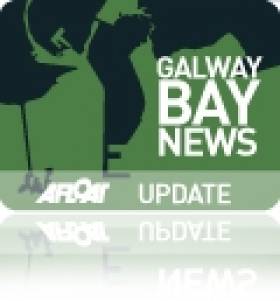Displaying items by tag: Barna
A memorial to several currach fishermen, which was vandalised last year, has been replaced with a new cut stone version at Galway’s Barna pier.
Relatives of the fishermen, William “Liam” Gill (78) and Peter Faherty (53), were so upset by the damage to the plaque that they commissioned a replacement.
Gill and Faherty, his son-in-law, drowned when their currach filled with herring sank an estimated 80 yards from the Barna shoreline in October 1922.
Both men had learned to swim, having served in the British Navy. Their third crew member, Michael (Michil Frank) Coyne, couldn’t swim, so Faherty helped rescue him, using the currach’s oars to support him towards the shore.
However, Gill was trapped in the nets, and Coyne swam back to save him and also got tangled in the gear. Neither of the two survived.
 The late William Gill who died off Barna pier a century ago, photographed with his family
The late William Gill who died off Barna pier a century ago, photographed with his family
The Connacht Tribune of October 21st, 1922, reported that their bodies were found close to the currach about a mile east of the village at Léana.
“The remains of William Gill were placed in a coffin and those of Peter Faherty in a cart, and they were taken to Barna amidst every demonstration of regret,” the newspaper reported.
“Faherty had a wife and a family of seven, six girls and one boy, and much sympathy is extended to Mrs Faherty in her great loss,” it reported.
At the inquest, survivor Michael Coyne said that both of the two men kept a grip “on the canoe” - as the currach was called - all the time.
 Peter Faherty, a former Royal Navy stoker, who drowned off Barna in 1922
Peter Faherty, a former Royal Navy stoker, who drowned off Barna in 1922
“When I shoved myself away from the canoe, I was full sure myself that I was going down. I had the oars under the arm, and they kept up my head,” he said.
“The canoe would have drifted ashore only for the weight of the nets, some of which had fallen out of the boat,” he told the inquest.
Last year, a stone from the original pier, fitted with a plaque to the two fishermen, which was carved by Denis Goggin and Ray Flaherty, was damaged. The incident, which occurred less than a month after it was unveiled, was reported to the Garda, and CCTV footage captured in the area was sought as part of an investigation.
A new plaque has been fitted by stonemasons Peter and John Greaney, who are related to both men.
 John (left) and Peter Greaney fitting the replacement plaque to the two fishermen at Barna pier Photo: Joe O'Shaughnessy
John (left) and Peter Greaney fitting the replacement plaque to the two fishermen at Barna pier Photo: Joe O'Shaughnessy
“Peter Faherty is our great grandfather, and William Gill is our great great grandfather,” Peter Greaney explained.
Galway historian Cormac Ó Comhraí gave the historical context when he spoke at the original unveiling. He recounted how the country was “so disturbed” by the Civil War that in the week that the two men drowned, it was also reported that the Clifden-Galway railway line had not run in three months.
Ó Comhraí said there were repeated warnings of famine in Connemara, and fishing was poor in Galway during that period – “a coincidence that many have affected the men’s judgment in October 1922”.
He said that William Gill, also known as Liam Rua or Liam Goill, was born at the time of the Great Famine, and the trauma of his early years would have increased his fear of the threat of famine.
When they caught a large quantity of herring, they would have been under pressure to land it all ashore.
After the men died, a fund was set up by clergymen to collect money for the two families. Among those who contributed was a large subscription from the people of Castlegar across the city.
Barna Family Home Boasts Galway Bay Views
#WaterfrontProperty - The Galway Advertiser has details of a detached family home near Barna with views over Galway Bay on the market for €570,000.
The waterfront house sits on a half-acre site and comes with spacious rooms featuring south-facing windows, designed "to allow free flow" through the home.
Also worth noting is the large attic with potential for conversion, ad the planned gardens between the house and its spectacular vista over the bay.
The Galway Advertiser has more on this property HERE.
Galway Lifeboat Rescues Three From Vessel Adrift Off Barna
#RNLI - Galway RNLI came to the rescue of two men and a child whose boat got into difficulty off Barna Pier in Galway Bay yesterday afternoon (Friday 22 August).
The 18ft bayliner was about half a mile off Barna when its engine failed. The boat drifted for some 30 minutes before the men on board called 999, at about 2.20pm.
The Irish Coast Guard sought the assistance of the Galway lifeboat, which launched from the city docks 10 minutes later.
The lifeboat crew of helm Kieran Tolan, David Badger, Olivia Bryne and Dara Oliver quickly arrived on scene and took the vessel in tow back to Barna. None of the people on board required medical attention.
Speaking after the callout, Tolan said: "Conditions were calm, with an offshore breeze, and although at the time they were in no immediate danger, they did the right thing in calling the lifeboat as situations on the water can change very quickly into more serious incidents."
Galway RNLI Rescues Man From Boat At Barna Rocks
#RNLI - Galway RNLI came to the rescue of a man whose 25ft sailboat almost hit rocks off Barna in Galway Bay on Sunday morning (9 June).
The alarm was raised by a member of the public who spotted the boat veering dangerously towards rocks south east of Barna Pier just before 11am. He contacted the Irish Coast Guard, who sought the assistance of Galway RNLI.
The volunteer lifeboat crew arrived at the scene at 11.14am and towed the sail boat out of difficulty. There was one person on board.
Galway RNLI lifeboat operations manager Mike Swan says with so many people on the water in this good weather, it's important that people be aware of the dangers in their local area.
The lifeboat crew on this call out were helmsman Declan Killilea, David Oliver, David Badger and Martin Oliver. Conditions were flat and calm.
Post-Mortem Scheduled for Body Recovered from Galway Bay
#GalwayBay - A post-mortem was scheduled for today (25 January) to determine the cause of the death of a man recovered from Galway Bay yesterday, according to the Irish Examiner.
As Galway Bay FM reported yesterday, the body was taken from the sea off Barna in a search operation mounted by the Galway RNLI lifeboat and the Irish Coast Guard after a friend reported him missing.
The man has last been seen on Barna beach earlier in the day. His body was recovered some two miles out to sea around 2.30pm yesterday.
Gardaí at Salthill are investigating the incident.
New Archaeological Discoveries in Galway Bay
#GALWAY BAY NEWS - Archaeologists in Galway Bay have unearthed an extensive tidal weir complex at Barna and a late medieval quay on Mutton Island, The Irish Times reports.
The weir, which is estimated to date from the early Christian period, consists of a granite barrier with channels cut through it, designed to control the flow of water in the adjacent lagoon.
Connemara archaeologist Michael Gibbons suggests that the weir implies a considerable fish stock migrating through the area into the Barna river.
The remains of a large Iron Age fort which overlooks the site may also have given its name to the townland of Knocknacarra, which is now a populous suburb of Galway.
Meanwhile, further east at Mutton Island a medieval quay which predates the current lighthouse quay has been found.
The Irish Times has more on the story HERE.
Buzzing Across Galway Bay?
A new ferry route has been proposed for Galway Bay, between Ballyvaghan at the north end of the Burren in County Clare, and Galway City in the famous Bay's northeast corner writes WM Nixon. The Clare village is at the head of its own bay within the shelter of Black Head, Galway Bay's southwest headland. A pretty place, Ballyvaghan is heavily reliant on providing hospitality for visitors drawn to the unique attractions of the Burren region, but the locals feel that the traffic holdups in the 50 km drive around from Galway can act as a disincentive for tourists.
Then too, the proposed 12-seater fast ferry – which could make the eleven mile crossing in 30 minutes or less – would be an attraction in itself. Having savoured the convenient waterfront charms of Galway City – from which they can already take popular boat trips on Lough Corrib – it's easy to believe that visitors would enjoy a quick sea voyage to somewhere entirely different.
Galway Bay Hop spokeswoman Gwen Ryan of Ballyvaghan claims that the ferry would also be useful for commuters travelling daily to work in the thriving commercial hub around the city. Then too, the fact that the ferry is of a manageable size means that it could also be used for group hire to visit many of the other small tidal ports around Galway Bay such as Kinvara and Barna, and perhaps even take in the legendary oyster pub Moran's of the Weir near Kilcolgan.
The idea first emerged from a Community Think-in at Ballyvaghan in the Spring of 2010, and if a feasibility study gives the right signals, the service could be operational by next year.





























































